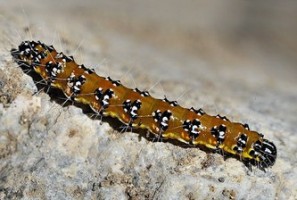By Scott Barnes

Mature genista broom moth caterpillar
Photo from Penn State Extension
At the June yard tour, Dave Tylka talked about a caterpillar that ate all the leaves on his Indigo plant last year. I had the same problem, and was surprised to learn I wasn’t alone. The caterpillar belongs to the Broom Moth. I looked them up and learned they can defoliate an indigo in just days.
I took the route of removing the caterpillars and cutting down the Indigo they had chosen as a food source. My decision was based on the fact that I have a number of different Indigos, and did not want them all defoliated. This year the Indigo I cut down came back with no ill effects. I will keep a look out and update this blog if I get a repeat experience this year.
Read more about these pests and different control measures on the Penn State Extension website.


Not indigos!
Are we talking of Baptisia australis? Or Amorpha fruticosa?
The Penn State report stated Baptisia australis. My neighbor had the same issue last year.
Betty I found it on my wild blue indigo (Baptisia australis) only. In Pollinators of native plants page 63 they talk about the Genista broom moth defoliating wild white indigo (Baptisia lactea). Personally I have had no experience with false indigo (Amorpha fruticosa) except to cut it back in a display garden. Maybe someone else has had some and will post it.
The Penn State report also mentioned damage on other plants in the pea family, Fabaceae. Amorpha fruticosa is in that family, too.